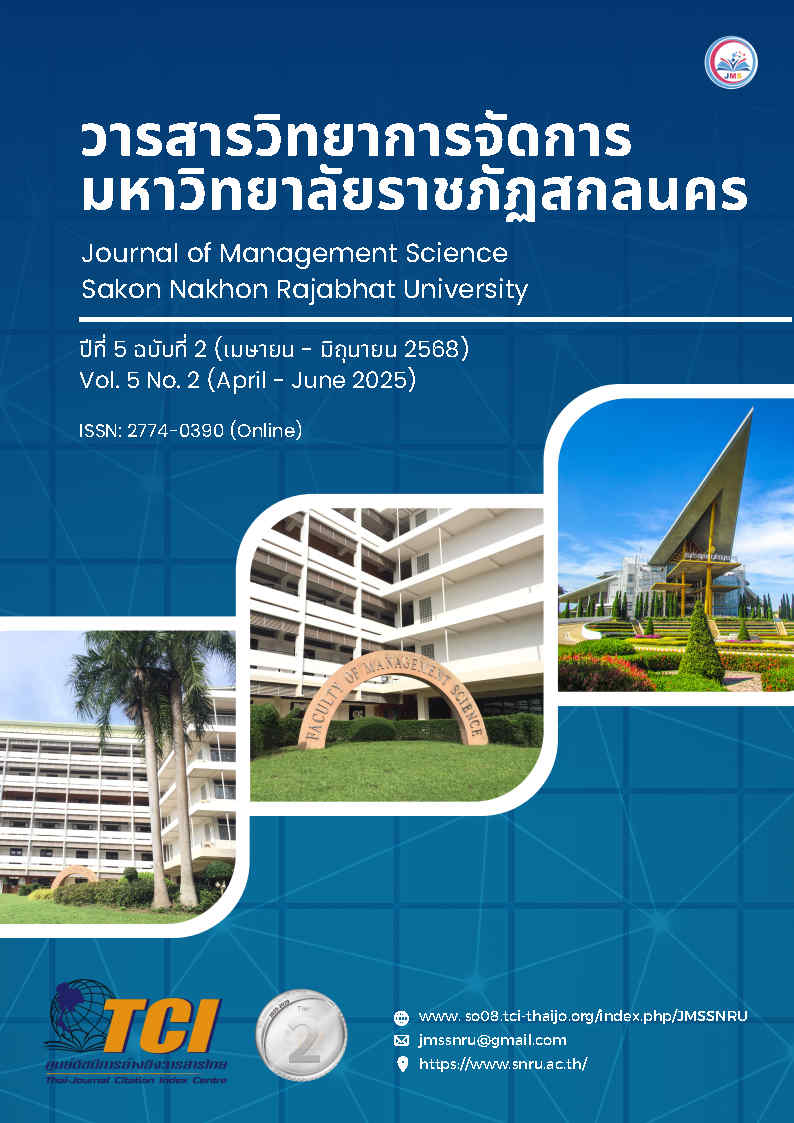Personnel management guidelines based on the Seven Kalayanamitta Dhamma Principles for school administrators under Mahasarakham Primary Educational Service Area Office 2
Keywords:
guidelines, Personnel Management, Seven Kalayanamitta Dhamma PrinciplesAbstract
The objectives of this research are to 1) study the current conditions, desirable conditions and essential needs in personnel administration based on the principles of the Seven Qualities of a Good Friend (Kalayanamitta) among school administrators and 2) propose guidelines for personnel administration based on these principles for school administrators. The sample group consisted of 317 school administrators and teachers from schools under the jurisdiction of the Maha Sarakham Primary Educational Service Area Office 2, along with 5 key informants. The research instruments included a five-point Likert scale questionnaire, with a content validity index ranging from .67 to 1.00 and the current reliability at .97, desired reliability at .96, and a verified interview. The statistical analyses included mean, standard deviation, and an assessment of essential needs using the Modified Priority Needs Index (PNI Modified). The research findings revealed that 1) the current conditions of the personnel management guidelines of school administrators under Maha Sarakham Primary Educational Service Area Office 2 based on the Seven Principles of a Good Friend Kalayanamitta were at a moderate level. The highest level was found in desirable conditions. When considering each aspect of essential needs, the highest average score was found in the aspect of workforce planning and position management. 2) Guidelines of school administrators under the jurisdiction of the Maha Sarakham Primary Educational Service Area Office 2 included 2.1) promoting trainings, seminars and producing personnel development planning, 2.2) The aspect of workforce planning and position management involved analyzing and managing data systematically, 2.3) The aspects of recruitment, placement, and appointment areas were associated with good governance, consecutive and reasonable follow-up, 2.4) The area of personnel retention involved rules of practices and agreements. We should focus on reasonable raises, promotions, and respect, and 2.5) The area of performance evaluation and assessment included creating understanding of performance indicators and procedures and reducing unnecessary working processes and assessments.
References
กระทรวงศึกษาธิการ. (2546). พระราชบัญญัติการศึกษาแห่งชาติพุทธศักราช 2542 แก้ไขเพิ่มเติม (ฉบับที่ 2) พุทธศักราช 2545. กรุงเทพฯ: คุรุสภา.
บุญชม ศรีสะอาด. (2553). การวิจัยเบื้องต้น (พิมพ์ครั้งที่ 8). กรุงเทพฯ: สุวีริยาสาส์น.
ปัญญาวัฒน์ สังฆะ และนิยดา เปี่ยมพืชนะ. (2566). ความต้องการจำเป็นและแนวทางการบริหารงานบุคคลในสถานศึกษาขนาดเล็ก สังกัดสำนักงานเขตพื้นที่การศึกษาประถมศึกษาขอนแก่น เขต 5. วารสารพุทธปรัชญาวิวัฒน์, 7(1), 488-499.
วนิดา เหลนปก. (2560). การบริหารงานบุคคลของโรงเรียนวัดราษฎร์บำรุง (ไสวราษฎร์อุปถัมภ์). การค้นคว้าอิสระศึกษาศาสตรมหาบัณฑิต สาขาวิชาการบริหารการศึกษา มหาวิทยาลัยศิลปากร.
วิภาดา สารัมย์. (2562). การบริหารงานบุคคลของผู้บริหารสถานศึกษาในเขตพื้นที่การศึกษาประถมศึกษาปทุมธานี. วิทยานิพนธ์ศึกษาศาสตรมหาบัณฑิต สาขาวิชาการบริหารการศึกษา มหาวิทยาลัยเทคโนโลยีราชมงคลธัญบุรี.
ศศิวิมล คนเสงี่ยม. (2563). การบริหารงานบุคคลของผู้บริหารสถานศึกษา สังกัดสำนักงานเขตพื้นที่การศึกษาประถมศึกษานครนายก. วิทยานิพนธ์ศึกษาศาตรมหาบัณฑิต สาขาวิชาการบริหารการศึกษา มหาวิทยาลัยเทคโนโลยีราชมงคลธัญบุรี.
ศิริรัตน์ มกรพฤกษ์. (2559). การศึกษาความสัมพันธ์ระหว่างพฤติกรรมผู้นำของผู้บริหารสถานศึกษากับการบริหารงานบุคคลของโรงเรียน สังกัดสำนักงานเขตพื้นที่การศึกษาประถมศึกษาพระนครศรีอยุธยา เขต 1. วิทยานิพนธ์ครุศาสตรมหาบัณฑิต สาขาวิชาการบริหารการศึกษา มหาวิทยาลัยราชภัฏพระนครศรีอยุธยา.
สุเทพ เท่งประกิจ. (2557). การบริหารงานบุคคลของผู้บริหารสถานศึกษาขั้นพื้นฐาน สำนักงานเขตพื้นที่การศึกษาประถมศึกษายะลา เขต 2. การค้นคว้าอิสระครุศาตรมหาบัณฑิต สาขาวิชาการบริหารการศึกษา มหาวิทยาลัยราชภัฏยะลา.
อมร เอื้อกิจ. (2565). การบริหารทรัพยากรบุคคลของมหาวิทยาลัยมหามกุฏราชวิทยาลัย. วิทยานิพนธ์ศึกษาศาสตรมหาบัณฑิต สาขาวิชาการบริหารการศึกษา มหาวิทยาลัยมหามกุฏราชวิทยาลัย.
Armstrong, M. (1995). A handbook of personnel management practice (5th ed.). London: Kogan Page.
Cascio, W. F. (1992). Managing Human Resources (3rd ed.). New York: McGraw-Hill.
Castetter, W. B. (1992). The personnel function in education administration. New York: Macmillan.
krejcie, R.V., & Morgan D.W. (1970). Determining Sample Size for Research Activities. Educational and Psychological Measurement, 30(3), 607–610.
Mondy, R. W., & Noe, R. M. (1990). Human Resource Management (4th ed.). Boston: Allyn and Bacon.
Story, M. (2005). A Perspective on Family Meals Do They Mmatter? Nutr Today, 40(6), 261-266.
Downloads
Published
How to Cite
Issue
Section
License
Copyright (c) 2025 JOURNAL OF MANAGEMENT SCIENCE SAKON NAKHON RAJABHAT UNIVERSITY

This work is licensed under a Creative Commons Attribution-NonCommercial 4.0 International License.
An article published in the Journal of Management Science. Sakon Nakhon Rajabhat University is the opinion, copyright and responsibility of the author of the work.






